Bourdon & Richard Aneroid Barometer On Stand Retailed By Eg Wood 74 Cheapside

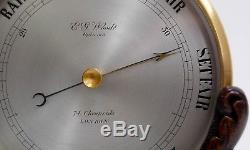
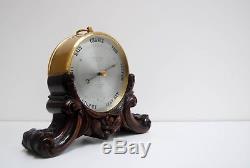
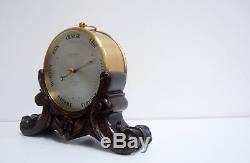


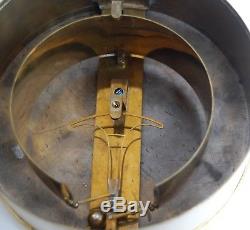
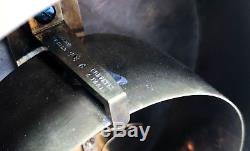

A very early Series 2 Bourdon & Richard aneroid barometer on stand retailed by EG Wood, 74 Cheapside, London. This rare example of a bourdon barometer has a five inch silvered dial showing 28 to 31 inches of barometric pressure and is engraved to the famous optician and scientific instrument maker EG Wood at 74 Cheapside, London. It has a blue steel indicating hand and a brass pointer operated by a knurled knob to the front of the glass. Unlike most aneroid barometers of the period, the brass drum case has a removable back with two slots which is secured by means of two pins affixed to the drum. To remove the back, the slots are aligned with the pins and the back lifts off.
The movement has Bourdons tell-tale crescent shaped flattened vacuum tube with fan shaped rack operated by twin levers and is stamped to the top of the mechanism with the name, Bourdon Richard, Brevete a Paris It also contains the serial stamp, Serie 2 No. The Series 2 represented a slight improvement to Bourdons Series 1 movement and this example is an extremely early example of that change being numbered at only 246. It still maintains the early anchor shaped rack rather than the later tear-dropped version and non-adjustable lever mechanism. The barometer is mounted on its original and superbly carved oak base which is of somewhat smaller proportions than most bases of the period.
It is devised of a floral central motif and outswept C scrolled legs which have developed a superb patina over the last one hundred and fifty years. Bourdons designs for both barometers and pressure gauges were met with approval at The Great Exhibition in 1851 winning him a council medal alongside his competitor Vidie. Bourdons movement however were slightly more fragile than Vidies and although they continued to be produced until the turn of the century, they were less well received. As early as 1863, Admiral Fitzroy, Chief of the Meteorological Department of the Board of Trade commented that, they are not so well adapted for travellers, nor for the measurements of considerable elevations, as Vidie aneroids, which in some part contributed to the lack of uptake in the UK. Bourdon continued to work on numerous other designs and eventually became more renowned for his work on pressure gauges.
He was a prolific inventor and died in 1884 whilst undertaking experiments on the effects of wind on steam locomotives. A fall from a moving carriage resulted in a head injury from which he died a few days following the accident and was buried in Pere Lachaise cemetery, Paris. His barometer movements are today prized for their workmanship, beauty and for their rarity.
From 1833 to 1843, Wood seems to have worked alone or with his brothers, Henry & George Wood from premises in King Street and Shepperton Street in London. It is possible that Wood, initially supplied the trade with finished parts for constructing instruments as I can find no examples of his work with the early addresses. This assumption can be evidenced by recent research by Brian Stevenson through an 1844 newspaper advertisement announcing that Messrs Horne, Thornwaite & Wood have acceded to the business of Edward Palmer, having been assistants and manufacturers to him since his first establishment in Newgate Street in 1837. Palmer was a highly successful instrument maker and retailer of the period.
Given the above, we know that in 1844, Wood entered the successful partnership of Horne, Thornwaite and Wood, trading at Palmers old address of 123 Newgate, London and later expanding into 121 Newgate. The company exhibited numerous devices at The Great Exhibition and won a Prize Medal for photographic equipment. Nothing is known of Woods reasoning but in 1854, the partnership was dissolved with Wood leaving to form a company under his own name, established at 117 Cheapside and the other partners continuing under the name of Horne & Thornwaite where they maintained a successful business, gaining royal approval from Queen Victoria and signing their instruments with, philosophical instrument makers to Her Majesty. In 1862, Wood moved his business to his better known address of 74 Cheapside and it remained there until his death in 1895. He did however, return to business with his old partners for a brief period in 1886 until 1893 whilst his business of EG Wood was maintained under family ownership. The business seems to have diversified into electrical engineering during its later existence and was finally bought out by Dollond & Co Ltd in 1912. Edward George Wood was an extremely capable instrument maker and inventor, whilst in partnership, he invented the first vertical double magic lantern or biunial for which he is best known but numerous scientific instruments such as barometers, telescopes and of course photographic instruments are known to bear his name. This superb and rare bourdon barometer would have been imported by Wood from Bourdon and Richard in Paris and the dial would have been engraved to EG Woods for retailing at his premises. Given the early Series Two movement we can date the instrument to the earliest part of his tenure at 74 Cheapside, circa 1862.Bourdon movements of this age are extremely rare. Jason Clarke Antiques are happy to discuss carriage, condition or for any other queries, alternatively, you can also message me and I will endeavour to come back to you as soon as possible. I have a number of beautiful antiques for sale, so please feel free to browse my other items. The item "BOURDON & RICHARD ANEROID BAROMETER ON STAND RETAILED BY EG WOOD 74 CHEAPSIDE" is in sale since Tuesday, June 5, 2018. This item is in the category "Collectables\Scientific Collectables\Scientific Instruments\Barometers".
The seller is "jason750_1" and is located in newbury, Berkshire. This item can be shipped to United Kingdom.
- Featured Refinements: Aneroid Barometer
- Period: 1800 to 1900
- Sub-Type: Barometers
- Country/Region of Manufacture: France
- Material: Brass
- Type: Scientific Instruments

